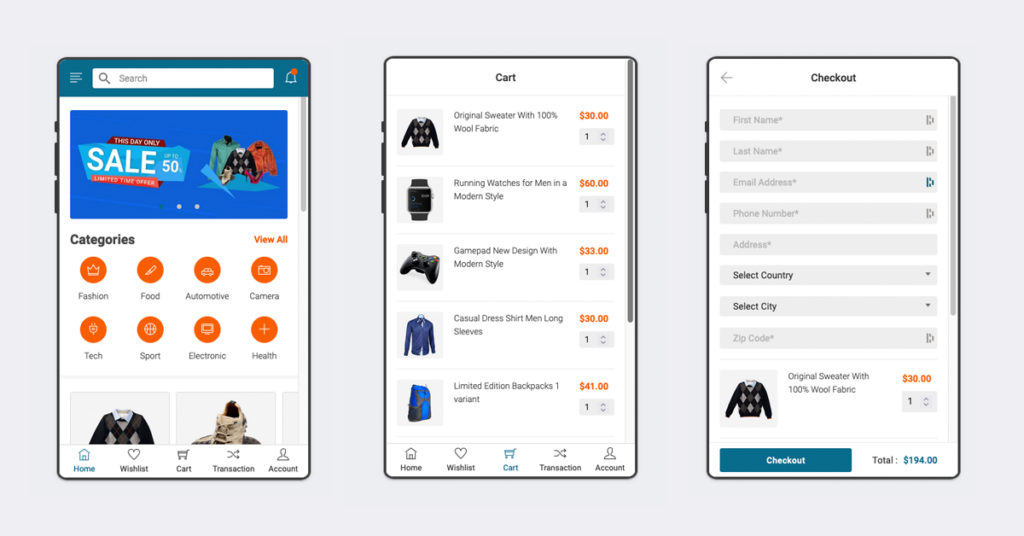
In the ever-evolving world of digital commerce, the challenge of online shopping cart abandonment remains a critical hurdle for online retailers. As we step into 2025, the urgency to understand and mitigate the factors leading to abandoned carts has intensified. This comprehensive guide delves into “10 Effective Strategies to Reduce Shopping Cart Abandonment in 2025,” offering a deep dive into innovative and practical solutions.
From optimising the e-commerce checkout experience to leveraging data analytics and engaging customer interaction strategies, this article provides a roadmap for online retailers to enhance their checkout processes, tailor customer experiences, and ultimately, convert abandoned carts into successful sales. Embrace these insights to stay ahead in the competitive digital marketplace and transform your e-commerce challenges into opportunities for growth and customer loyalty.
Understanding Shopping Cart Abandonment
Shopping cart abandonment is a significant issue for ecommerce businesses, resulting in lost revenue and missed opportunities to build community and form relationships with shoppers. In this section, we will delve into the concept of shopping cart abandonment, its average rate, and the effects it has on ecommerce sales.
What is shopping cart abandonment?
Shopping cart abandonment occurs when a customer adds items to their shopping cart but leaves the site before completing the purchase. This can happen due to various reasons, including extra costs, creating an account, checkout process complexity, payment security concerns, unsatisfactory return policy, not enough payment methods, website errors, or slow load times. Understanding these factors is crucial for online retailers aiming to reduce shopping cart abandonment and improve their checkout process.
Average shopping cart abandonment rate
The average shopping cart abandonment rate is around 69.99%, according to Baymard Research Institute. This means that nearly 70% of online shoppers abandon their carts before completing the purchase. Such a high rate of cart abandonment highlights the need for online retailers to optimize their checkout pages and address the common pain points that lead to cart abandonment.
Effects of shopping cart abandonment on ecommerce sales
Shopping cart abandonment can have a significant impact on ecommerce sales. According to Forrester Research, the amount of annual sales revenue lost to digital shopping cart abandonment is $18 billion. Moreover, a high shopping cart abandonment rate can also lead to missed opportunities to build community and form relationships with shoppers, ultimately affecting brand loyalty and reputation. By understanding the effects of shopping cart abandonment, online retailers can take proactive steps to reduce their shopping cart abandonment rates and enhance their overall ecommerce sales.
Common Reasons for Shopping Cart Abandonment
Shopping cart abandonment can occur due to various reasons. In this section, we will explore some of the common reasons for shopping cart abandonment, including unexpected shipping costs and lack of transparency.
Unexpected shipping costs and lack of transparency
Unexpected shipping costs are a leading cause of shopping cart abandonment. According to Baymard Institute, 48% of shoppers with actual purchase intent abandon shopping carts because the extra costs (shipping, taxes, and fees) are too high. Moreover, a lack of transparency regarding shipping costs can also lead to cart abandonment. Online retailers should provide clear and upfront information about shipping costs to avoid surprising customers at the checkout page.
By understanding the common reasons for shopping cart abandonment, online retailers can take steps to reduce cart abandonment and improve the overall online shopping experience. In the next section, we will explore strategies for reducing shopping cart abandonment.
1. E-commerce Checkout Optimisation

Enhancing the Checkout Experience
In the dynamic world of e-commerce, addressing the phenomenon of shopping cart abandonment is more crucial than ever. As we step into 2025, online retailers must thoroughly understand the reasons behind abandoned carts and take proactive measures to address them. The checkout process represents a critical juncture in the customer journey, where shoppers decide whether to complete their purchases or leave their carts behind. Therefore, optimizing this process is essential for improving conversion rates and overall profitability.
Streamlining the Checkout Process
Effective checkout optimization requires a comprehensive analysis of the existing process to identify areas where customers may encounter friction or frustration. These issues can range from a complicated navigation system and unexpected costs to a lack of payment options or security concerns.
Once identified, retailers can streamline the process by simplifying forms, providing transparent pricing information, offering a variety of payment methods, and ensuring a secure and trustworthy checkout experience. Consistency in design and messaging throughout the website is vital to building trust and reassurance, which are crucial in convincing customers to finalize their purchases.
Retailers should also consider optimizing the different paths customers take to reach the checkout, ensuring a smooth transition at every step. By focusing on these areas, businesses can significantly reduce shopping cart abandonment rates and boost their sales.
Building Trust and Consistency
Moreover, the checkout experience should align with the rest of the website in terms of design and messaging. Consistency helps build trust and reassurance, which are crucial in convincing customers to complete their purchases. Retailers should also consider optimizing the various paths customers take to reach the checkout, ensuring a seamless transition. By addressing these areas, businesses can significantly reduce shopping cart abandonment rates and increase their sales.
Ultimately, addressing shopping cart abandonment involves understanding customer behavior and preferences. By analyzing data and implementing targeted strategies, retailers can create a more enticing and seamless shopping experience. This approach not only reduces cart abandonment but also fosters long-term customer loyalty, turning potential challenges into opportunities for growth and success.
2. Streamlined Checkout Process

Crafting an Intuitive Checkout Experience
In the competitive world of e-commerce, the checkout process is a pivotal stage where customer conversion is often determined. A streamlined checkout process transcends merely reducing the number of steps; it is about crafting an intuitive, efficient, and hassle-free journey for the customer.
As we advance into 2025, online shoppers expect a checkout experience that is not only quick but also straightforward. Meeting these expectations requires a thorough understanding of the customer journey and the potential friction points that might deter them from completing their purchase.
Analyzing and Refining the Checkout Flow
Retailers should start by conducting a comprehensive analysis of their current checkout flow to identify and eliminate unnecessary steps that could hinder the customer experience. This involves asking critical questions: Can information be auto-filled to save time? Is the process intuitive enough for someone who is not tech-savvy?
Simplifying the process might involve reducing the number of pages, combining steps where possible, and eliminating non-essential fields in forms. Such refinements can significantly enhance the checkout experience, making it more seamless and user-friendly.
Enhancing Guidance and Support
Providing clear instructions and feedback throughout the checkout process is crucial for maintaining customer engagement. Customers should always know what step they are on, what is required of them, and what comes next.
Progress indicators serve as an effective tool in this regard, helping customers feel more in control of the process. Additionally, offering options like guest checkout can significantly reduce barriers for new customers who might be hesitant to create an account. This flexibility is essential in catering to diverse customer preferences and enhancing the overall shopping experience.
Visual Design and Security Assurance
The visual design of the checkout process plays a critical role in influencing customer decisions. A cluttered or visually overwhelming checkout page can deter customers from completing their purchase. Maintaining a clean, simple design that aligns with the rest of the site helps maintain the customer’s focus and reduces cognitive load.
Moreover, payment security concerns are paramount, as customers need to trust that their credit card details are safe. Enhancing security features on transaction forms and displaying recognizable trust signals can help build this trust, reassuring customers that their data is protected.
Building Trust Through Consistency
Consistency in design and messaging throughout the website is vital for building trust and reassurance, which are crucial in convincing customers to finalize their purchases. Retailers should also consider optimizing the various paths customers take to reach the checkout, ensuring a seamless transition at every step.
By focusing on these areas, businesses can significantly reduce shopping cart abandonment rates and boost their sales. Ultimately, addressing shopping cart abandonment involves understanding customer behavior and preferences. By analyzing data and implementing targeted strategies, retailers can create a more enticing and seamless shopping experience, fostering long-term customer loyalty and turning potential challenges into opportunities for growth and success.
3. Mobile-Friendly Checkout

Embracing Mobile-Friendly Checkout
In today’s digital age, where smartphones dominate the landscape, a mobile-friendly checkout process is essential. As we progress into 2025, a substantial portion of online shopping occurs on mobile devices. Retailers who neglect to optimize their checkout process for mobile risk facing increased cart abandonment rates.
Designing for Mobile Efficiency
Creating a mobile-friendly checkout process involves understanding the unique characteristics of mobile devices. This means incorporating large, easy-to-tap buttons, minimizing text input, and ensuring fast loading times. Since typing on mobile devices can be cumbersome, using dropdowns, toggles, and auto-fill options can significantly enhance the user experience.
Responsive and Adaptive Design
A responsive checkout process should seamlessly adapt to various screen sizes and orientations. This includes not only the layout but also the size of clickable elements, visibility of crucial information, and the overall navigational flow. Ensuring a smooth transition between different screen sizes enhances the shopping experience for mobile users.
Integrating Mobile Payment Options
Integrating mobile payment options such as Apple Pay, Google Wallet, or other region-specific methods is crucial. These options not only expedite the checkout process but also offer a more secure way for customers to pay. Additionally, clearly communicating security and privacy measures helps build trust with mobile users who may have concerns about transaction security.
Building Trust with Mobile Shoppers
Ultimately, optimizing for mobile involves more than just design; it’s about creating a seamless and secure shopping experience. By addressing mobile-specific needs and ensuring a trustworthy checkout environment, retailers can significantly reduce cart abandonment rates and enhance customer satisfaction. As mobile shopping continues to grow, adapting to these trends is vital for staying competitive in the e-commerce landscape.
4. Effective Customer Engagement

Understanding Effective Customer Engagement
In the competitive world of e-commerce, effective customer engagement is key to reducing shopping cart abandonment. As we move into 2025, the online marketplace is more competitive than ever, making it essential to not only attract customers to your site but also provide an experience that keeps them coming back. It’s crucial to understand the behavior of window shoppers who show interest but often abandon their carts. By enhancing customer engagement, you can convert these visitors into buyers.
Personalization and Data Insights
The foundation of customer engagement begins with a deep understanding of your audience. Knowing their needs, preferences, and pain points is essential. Utilizing data analytics to gather insights about your customers allows you to tailor the shopping experience to their preferences. Personalization plays a pivotal role here. From personalized product recommendations to customized email marketing, demonstrating that you understand your customers’ needs can significantly boost engagement.
Interactive Experiences and Communication
Incorporating interactive elements such as chatbots, AR/VR experiences, and interactive product demos can elevate the customer experience. These tools not only provide value but also create memorable interactions that set your brand apart from competitors. Consistent and meaningful communication is also vital. Whether through social media, email newsletters, or blog posts, maintaining contact with your customers and offering valuable content helps build a community around your brand.
Building Long-term Customer Relationships
Engaged customers are more likely to return to your site, and when they do, they’re more likely to complete their purchases. By focusing on personalized experiences, interactive elements, and consistent communication, you can create a strong foundation for long-term customer relationships. This approach not only reduces cart abandonment but also fosters brand loyalty, ensuring your customers keep coming back for more.
5. Personalised Shopping Experience

Creating a Personalized Shopping Experience
In the rapidly evolving world of e-commerce, a personalized shopping experience has become a crucial strategy. By 2025, personalization has advanced far beyond simply addressing customers by name in emails. It now involves tailoring the entire shopping journey to match individual customer preferences and behaviors, enhancing the overall experience when shopping online. This approach leverages advanced algorithms and machine learning to analyze customer data and predict shopping patterns, enabling the automatic recommendation of products that align with customer interests.
Leveraging Advanced Technology for Personalization
Personalization extends beyond product recommendations; it involves customizing the user interface, marketing messages, and even the checkout process based on each customer’s past behavior and preferences.
For example, if a customer frequently purchases eco-friendly products, the website can highlight these items more prominently for that customer. Similarly, if a customer often abandons carts due to high shipping costs, offering a personalized discount on shipping could encourage them to complete their purchase.
Ensuring a Seamless Omni-Channel Experience
A key aspect of personalization is providing a consistent experience across all channels, whether a customer is shopping on a desktop, mobile device, or in a physical store. This omni-channel approach ensures that customers feel recognized and valued, regardless of how they choose to interact with the brand. By maintaining consistency in interactions, retailers can build stronger relationships with their customers, fostering loyalty and repeat business.
The Power of Data-Driven Insights
The foundation of this personalized approach lies in the effective use of data-driven insights. By analyzing customer behavior and preferences, retailers can tailor their offerings to meet specific needs, enhancing the overall shopping experience. This data-driven strategy not only helps in understanding customer preferences but also allows for real-time adjustments in marketing strategies, ensuring that the customer journey remains engaging and relevant.
Driving Customer Satisfaction and Reducing Cart Abandonment
Ultimately, a personalized shopping experience is about more than just increasing sales; it’s about creating a satisfying and memorable journey for the customer. By addressing individual needs and preferences, retailers can significantly reduce cart abandonment rates and enhance customer satisfaction. As we move forward, embracing these personalized strategies will be essential for retailers aiming to thrive in the competitive e-commerce landscape.
6. Interactive Product Recommendations

Engaging Customers with Interactive Product Suggestions
Interactive product recommendations go beyond traditional suggestions by engaging customers in a dynamic and personalized way. In 2025, these sophisticated systems not only suggest products based on browsing history but also involve customers through interactive methods. For instance, quizzes or questionnaires can be used to provide tailored recommendations, enhancing customer engagement and delivering more accurate suggestions.
Leveraging Augmented Reality for Enhanced Shopping
Another innovative approach is the use of augmented reality (AR), allowing customers to visualize products in their own environment, whether it’s a piece of furniture in their living room or a new shade of lipstick. These interactive systems can utilize real-time data to adjust recommendations on the fly. For example, if a customer is browsing winter coats, the system can immediately start suggesting complementary accessories like gloves and scarves.
Seamless Integration for Improved Shopping Experience
The success of interactive product recommendations lies in their seamless integration into the shopping experience. They should be intuitive, easy to use, and highly relevant to the customer’s interests. When executed effectively, these systems can significantly enhance the shopping experience, leading to increased customer satisfaction and a reduction in shopping cart abandonment rates.
7. Customer Behaviour Analysis

Understanding Customer Behaviour in E-commerce
In the realm of e-commerce, comprehending customer behaviour is pivotal, especially when it comes to reducing shopping cart abandonment. By 2025, the sophistication of data analysis has reached new heights, providing insightful perspectives into how customers interact with websites.
This involves observing which products capture their interest, how much time they spend on specific pages, and the precise moments they abandon their carts. Such detailed analysis helps retailers pinpoint potential bottlenecks in the customer journey.
Identifying Pain Points in the Customer Journey
For instance, if a significant number of customers abandon their carts at the payment stage, this could signal issues with payment options or the process itself. Similarly, if customers leave after viewing shipping costs, it might indicate that the fees are perceived as too high or the delivery times too lengthy. By understanding these patterns, retailers can address the specific issues that deter customers from completing their purchases.
Tools and Techniques for Behaviour Analysis
Retailers have a variety of tools at their disposal to conduct this analysis, such as heat maps, session recordings, and analytics platforms. These tools offer a deeper understanding of customer behaviour, enabling retailers to make informed, data-driven decisions to enhance the shopping experience. By leveraging these insights, businesses can refine their strategies to better meet customer needs and expectations.
Segmenting customers based on their behaviour also allows for more targeted strategies. For example, customers who frequently browse without purchasing can be approached with special offers or reminders, while those who make regular purchases might benefit from a loyalty program. This level of personalization can significantly enhance customer engagement and satisfaction.
Ultimately, understanding and analyzing customer behaviour is a powerful strategy for reducing shopping cart abandonment. By addressing the specific pain points in the customer journey and tailoring strategies to individual behaviours, retailers can create a more seamless and satisfying shopping experience, fostering long-term loyalty and reducing the rate of cart abandonment.
8. Utilising Data Analytics

Harnessing Data Analytics for E-commerce Success
In the realm of e-commerce, data analytics has evolved into a powerful tool for transforming vast amounts of customer data into actionable insights. By 2025, advancements in data analytics have allowed retailers to not only track customer behavior but also predict future trends and preferences.
This involves collecting data from various sources, such as website interactions, social media, customer feedback, and purchase history. Analyzing this data helps retailers identify patterns and trends, such as which products are most popular at different times of the year, which marketing campaigns yield the best results, and what factors contribute to shopping cart abandonment.
Personalizing the Shopping Experience
One of the most significant advantages of data analytics is its ability to personalize the shopping experience. By understanding customer preferences and behaviors, retailers can tailor marketing messages, product recommendations, and even website layouts to better suit individual customers.
This personalized approach not only enhances customer satisfaction but also encourages repeat purchases. Furthermore, data analytics plays a crucial role in inventory management by predicting future trends and customer demand, ensuring that retailers have the right products in stock and reducing the likelihood of cart abandonment due to out-of-stock items.
Optimizing Inventory and Enhancing Customer Engagement
Data analytics also empowers retailers to optimize inventory management and enhance customer engagement. By predicting customer demand and future trends, retailers can ensure that popular products are always in stock, minimizing the risk of cart abandonment.
Additionally, personalized marketing strategies, informed by data insights, can create a more engaging shopping experience. This level of customization not only attracts new customers but also fosters long-term loyalty, ultimately reducing shopping cart abandonment rates and boosting overall sales.
9. Recovering Abandoned Carts

Effective Cart Recovery Techniques
Recovering abandoned carts is a crucial strategy for online stores navigating the competitive e-commerce landscape of 2025. With rising customer expectations, retailers must adopt proactive measures to reclaim lost sales.
One highly effective approach is the use of follow-up emails directed at customers who have left their carts behind. These emails serve as gentle reminders of the items they were interested in and encourage them to complete their purchases. By personalizing these messages with the customer’s name and detailing the specific products they abandoned, retailers can significantly enhance the effectiveness of this strategy.
Retargeting and Understanding Abandonment
Another powerful tool in the cart recovery arsenal is retargeting ads. These ads specifically target customers who have previously visited your site but left without making a purchase. By showcasing the products they viewed or added to their cart, retargeting ads help keep your brand and products at the forefront of their minds, enticing them to return and finalize their purchase.
Additionally, it is essential for retailers to understand the underlying reasons for cart abandonment. High shipping costs, a complicated checkout process, or mere browsing with no intent to buy are common culprits. By identifying these issues, businesses can address them head-on, thereby reducing the cart abandonment rate and enhancing the overall shopping experience.
Ultimately, understanding and addressing cart abandonment requires a multifaceted approach that combines personalization, retargeting, and problem-solving. By implementing these strategies, retailers can not only recover lost sales but also improve customer satisfaction and loyalty. As the e-commerce landscape continues to evolve, staying attuned to customer needs and expectations will be key to reducing cart abandonment and achieving success in the digital marketplace.
10. Retargeting Strategies

Retargeting stands as a formidable strategy in the e-commerce landscape, enabling retailers to reconnect with customers who have previously shown interest in their products but did not proceed to purchase. As we move into 2025, retargeting techniques are set to become more advanced, with capabilities to engage customers across various platforms and devices seamlessly.
This evolution in retargeting is not just about displaying ads for previously viewed products; it’s about crafting a compelling narrative that resonates with the customer, encouraging them to revisit your site. This could include offering exclusive discounts, emphasizing product benefits, or providing additional information to address any potential concerns.
Utilizing multiple channels such as social media, email, and display ads on other websites, retargeting ensures a consistent message is delivered across all platforms, aligning with the overall marketing strategy. The effectiveness of retargeting lies in its ability to maintain a cohesive message that speaks directly to the customer’s interests and needs, ultimately driving them back to the online store.
By strategically implementing retargeting, retailers can not only recover abandoned carts but also strengthen customer relationships, leading to increased loyalty and repeat purchases. In essence, effective retargeting is about more than just recovering lost sales; it’s about building a robust connection with customers that fosters long-term engagement and satisfaction.
By integrating retargeting into their marketing efforts, retailers can enhance their customer outreach, ensuring that their brand remains top-of-mind and encouraging customers to complete their purchases. This approach not only mitigates shopping cart abandonment but also cultivates a loyal customer base that is more likely to return for future transactions.
Final Thoughts on Reduce Shopping Cart Abandonment
As we navigate the complexities of e-commerce in 2025, the challenge of shopping cart abandonment remains a significant concern for online retailers. This guide has explored ten effective strategies aimed at tackling and reducing cart abandonment, ensuring a more robust and profitable online retail experience. Key areas of focus include optimizing the checkout process to be more user-friendly and efficient, enhancing the mobile shopping experience, and engaging customers through personalized interactions and data-driven insights.
Streamlining checkout processes and leveraging advanced data analytics for a personalized shopping journey are crucial strategies to meet the evolving expectations of modern consumers. By implementing interactive product recommendations and understanding customer behavior through detailed analytics, retailers can craft a more enticing and seamless shopping experience. Moreover, the strategic use of retargeting campaigns and effective communication channels can significantly aid in recovering abandoned carts and fostering long-term customer loyalty.
Ultimately, the success of an e-commerce business in 2025 hinges on its ability to adapt to these changing dynamics, leveraging technology and customer insights to create a shopping experience that not only attracts but retains customers. By embracing these strategies, retailers can transform the challenge of cart abandonment into an opportunity for growth and enhanced customer satisfaction.
For those looking to optimize their checkout cart and enhance their e-commerce strategy, reaching out to WDD Malaysia, a professional e-commerce website design agency, can provide tailored solutions that resonate with your audience. Their expertise in e-commerce optimization ensures that your online store not only attracts customers but also provides an experience that encourages them to complete their purchases. Contact WDD Malaysia today to elevate your e-commerce business to new heights.





